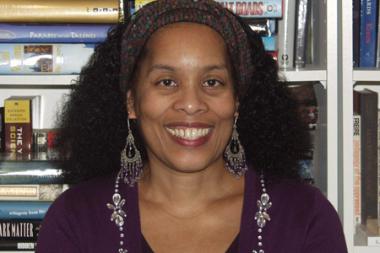The plays that Andrea Hairston writes and produces with Northampton’s Chrysalis Theater persistently confront big, enduring issues: violence, racism, the trials and triumphs of women, the importance of community, the power of art.
Those themes course through her novels, too. Her second, Redwood and Wildfire, has just been published by Aqueduct Press. It follows 2006’s Mindscape, a sci-fi adventure of cultural and political conflict, set in a future century. The new book is based on real-life history and rooted in the magic of theater—with a generous pinch of hoodoo magic as well.
Hairston’s work, on stage and page alike, insistently searches for signs that humans can overcome their divisions and oppressions, both external and self-inflicted. This book’s geographical, emotional and spiritual journeys, spanning the early years of the 20th century, are odysseys of self-discovery and healing from wounds of the body and soul. The novel mirrors the eclectic, cross-cultural composition of the Chrysalis company and Hairston’s own background—a multiracial poet-playwright-actor-musician-scholar who draws nourishment from diverse traditions.
Redwood Phipps is a black girl in Georgia who, at the age of 11, loses her mother to a lynch mob but inherits the woman’s gifts as a healer and hoodoo conjurer. Aidan Cooper is a half-Irish, half-Seminole farmer (his Indian name is Wildfire) who witnessed the murder and, helpless to save her, washes down the guilt with whiskey. Later, when Redwood kills a white man who is raping her, she flees to Chicago, where she becomes a singer and dancer in the burgeoning city’s bars and music halls. Aidan eventually follows, still battling the demon in the bottle, accompanied by Redwood’s kid sister Iris, herself an intuitive seer.
The Chicago scenes are enlivened by a multihued supporting cast, including a philandering black entrepreneur and his straitlaced wife; a gay dancer and his brother, a Persian prince; and the Boneyard Baron: death himself, who stalks and taunts the characters. There’s a subplot glimpse into the early silent movie industry, in which Redwood and Aidan are employed as extras, portraying “savage Injuns” in Westerns or “jigging and cooning” in “chicken-coop comedies”—demeaning roles that inspire Redwood to produce her own film in which “colored folk” are the heroes.
Redwood and Wildfire is a historical novel that vividly portrays two American worlds of a century ago: the backwoods of the rural South and the bustling, melting-pot energy of the industrial North. But Hairston’s interest isn’t only in recreating an era, but in creating the moral momentum for change in people’s hearts—the reader’s as well as her characters’. As Redwood insists, “What we do really does matter. Even if it don’t change everything … we be making the future now.”
The narrative is suffused with magic, faith healing, even an episode of time travel. But the most powerful conjurations, the charms that heal the soul, come through art. All the main characters are artists. Aidan is a banjo player, songwriter and diarist, Iris a budding screenwriter. Performers, Redwood says, “make the world up, in our dreams and in our songs… There’s a poem in your body up on stage.” Referring to both the power of hoodoo and the power of art, she adds, “We conjure this world, call it forth out of all possibilities.”
A free reading of excerpts from the book will be held on April 7 at 7:30 p.m. in the Nielson Library Browsing Room, Smith College.



